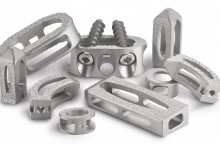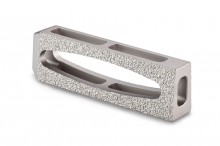Titan backbone Eyes bigger Slice of difficult Spinal Fusion Market

Jeff Engel, January 13, 2015
It’s arduous sufficient for a small firm to jostle for position in a crowded, however booming, industry. it can be even tougher when the sphere’s boom slows down, and an organization isn’t combating simply towards rivals—but in addition to win over critics who’re skeptical that anyone within the industry can deliver a product or service that consistently works.
That’s the challenge that Titan backbone, a Mequon, WI-primarily based producer of metallic implants used in spinal fusion surgical procedures, is up in opposition to.
the corporate, co-based a decade ago via Wisconsin spinal healthcare professional Peter Ullrich, makes titanium cages of quite a lot of styles and sizes for use in procedures that fuse collectively vertebrae within the lower back or neck of patients who’ve degenerative disc illness, an incessantly-painful deterioration of the gentle, elastic tissue located between vertebrae.
In these approaches, the healthcare professional removes the diseased disc and inserts the software between the vertebrae, frequently securing it with steel screws or rods. The implant acts as a spacer between the vertebrae, and bone taken from every other part of the patient’s body will also be inserted in the cage’s cavity, in the hopes that it helps secure the titanium software by way of growing thru it and melding with the vertebrae above and beneath.
The goal is to alleviate ache via stabilizing the spine and limiting its movement. but this type of surgical treatment isn’t guaranteed to do away with the pain, and it contains risks, including the possibility of an incomplete fusion with the vertebrae, which could warrant further surgical operation.
 Titan goals to fortify those effects by using growing titanium cages with a textured surface intended to spur bone formation and coax the brand new bone to latch onto the implant. the corporate uses an acid etching process to roughen the outer surface of its units and provide microscopic spikes and cavities onto which bone cells can take cling. In lab exams, Ullrich says, the surfaces do indeed appear to trigger the manufacturing of proteins associated with bone formation better than smooth titanium and polyetheretherketone (PEEK), a plastic subject matter that can also be used to make spinal fusion implants.
Titan goals to fortify those effects by using growing titanium cages with a textured surface intended to spur bone formation and coax the brand new bone to latch onto the implant. the corporate uses an acid etching process to roughen the outer surface of its units and provide microscopic spikes and cavities onto which bone cells can take cling. In lab exams, Ullrich says, the surfaces do indeed appear to trigger the manufacturing of proteins associated with bone formation better than smooth titanium and polyetheretherketone (PEEK), a plastic subject matter that can also be used to make spinal fusion implants.
Now the company is embarking on a clinical trial that it hopes will show that its surface know-how translates into certain outcomes for spinal fusion patients. And the corporate intends to work with the U.S. food & Drug Administration to lend a hand build a patient database that compares the implications of fusions involving Titan’s acid-etched titanium and those who used plastic and other competing implants, Ullrich says.
“We feel the principle benefit of a cage that may participate within the fusion course of, in comparison with cages that act as easy spacers, is that there’s the opportunity of patients to heal sooner,” Ullrich says. “hopefully, the medical data that we’re seeking to increase, in particular the information with the FDA, will endure this out.”
This idea of a rougher floor doubtlessly resulting in a greater merger of an implant and the physique isn’t a new idea. It has been used in dental and joint surgical procedures, and it’s changing into more commonplace within the spinal industry as smartly. Some firms, like Pennsylvania-primarily based Aesculap Implant systems, practice a titanium-based coating on a plastic implant to reach the desired effect. different techniques embody the 3D-printed implants made by way of Texas-based 4Web medical, which feature a roughened floor and a truss-like structure.
Ullrich co-invented Titan’s initial know-how within the early 2000s along with his buddy, Charanpreet Bagga, who at the time used to be vice chairman of product construction for Pennsylvania-based Orthovita, a spine surgical treatment biologics firm later obtained through Stryker (NYSE: SYK). Orthovita developed the implant instrument and secured FDA clearance to sell it in 2004. Ullrich started the use of the units in surgeries, and after a couple of years, he assembled a gaggle of business companions to buy the rights to the technology from Orthovita.
They shaped Titan, and launched the trade with seed capital from themselves, pals, and family. Bagga was once among the early employees, however later left the company to type any other trade, Ullrich says.
Titan has when you consider that raised an undisclosed amount of extra cash from folks, plus $ 2.6 million in debt funding, SEC documents express. the corporate has no longer taken any cash from institutional investors, co-founder and president Kevin Gemas says, instead opting to move at its own p.c. to grow body of workers, increase the outside technology, and promote its gadgets.
Titan’s sales grew nearly 25 p.c last 12 months, and its fourth quarter outcomes put it on p.c. for $ 25 million in annual sales, Ullrich says. lately, the company employs nearly 50 people, with offices in Mequon, Germany, and Spain. Its devices are used in about 200 U.S. hospitals, and in about 25 European hospitals. the company has also registered to do industry in Australia, New Zealand, and South Africa, Gemas says.
Titan not too long ago got FDA clearance to market titanium implants featuring a more advanced model of its surface know-how. “Our subsequent goal is to transform a advertising and gross sales juggernaut and in reality push into the industry that method and leverage off of what we’ve already done,” Ullrich says.
however whereas Titan is attempting to carve out a much bigger piece of the roughly $ 9 billion per yr spinal instrument market, the percent of business boom has slowed considerably, says Debbie Wang, a Chicago-based totally financial analyst with Morningstar. Wang covers Medtronic (NYSE: MDT), the … next page »
(139)













